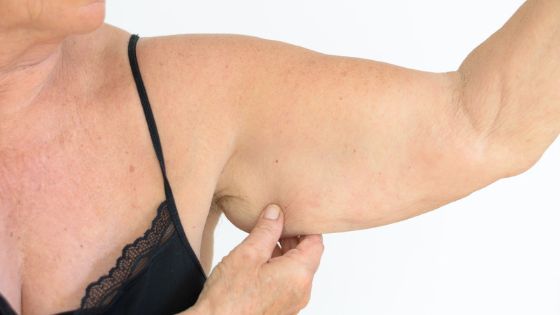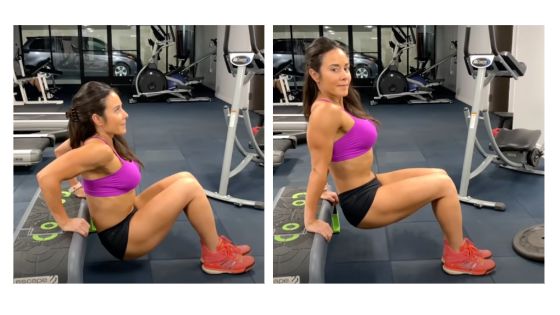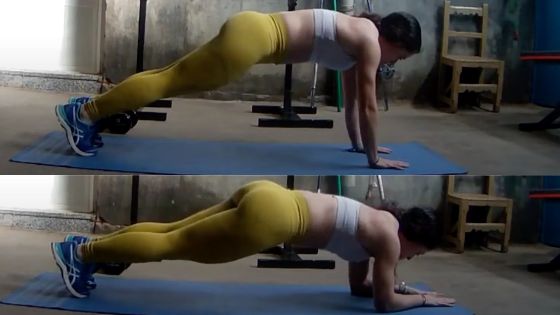The Best 10 Exercises for Flabby Arms Over 60!

Do you have flabby arms? As we age, physical performance and muscle strength decrease due to increased muscle mass loss, which impacts functional capabilities, resulting in slower walking, increased risk of falls, and decreased skills to perform day-to-day activities.
Flabby arms can be a common issue for people over 60. Luckily, some exercises can help strengthen and tone the muscles in your upper arms. Here are nine simple exercises that you can do to get started:
1- Triceps Push-ups

Technique
- Start in a plank position with your hands shoulder-width apart and feet hip-width.
- Bend your elbows to lower your body towards the ground, then press back up to return to starting position.
- Repeat this movement for 10 repetitions or as many as you can handle within 3-4 sets.
Pro Tips
- Keep your elbows close to your sides as you lower and raise your body.
- If you cannot complete the marked repetitions, do the push-ups with your knees on the floor.
2- Arm Circles

Technique
- Stand with feet shoulder-width apart and arms outstretched at shoulder level.
- Begin making small circles with your arms, gradually increasing the size of the circle.
- Do five circles in one direction and then switch directions for another five circles.
- Repeat this movement for 10 repetitions or as many as you can handle within 3-4 sets.
Pro Tips
- Keep your arms straight and circle them around without bending.
- Try to keep the circles as wide as possible to get a full range of motion.
3- Dumbbell Overhead Press

Technique
- Stand with feet shoulder-width apart and hold a dumbbell in each hand at shoulder level.
- Position your palms facing forward and press the weights upward until your arms are fully extended above your head.
- Return to starting position, maintaining control throughout the movement.
- Do this movement 10 times or as many repetitions as you can within 3-4 sets.
Pro Tips
- Keep your core engaged throughout the exercise.
- Do not lock out your elbows at the top of the press.
4- Bicep Curls

Technique
- Stand with your feet hip-width apart and hold a dumbbell in each hand.
- With your palms facing forward, curl both dumbbells up towards your shoulders, keeping the elbows close to the body.
- Return to starting position and repeat this movement for 10 repetitions or as many as possible within 3-4 sets.
Pro Tips
- Keep your core engaged throughout the exercise.
- Do not swing or jerk the weights up – curl them slowly and with control.
5- Dips

Technique
- Lean with your hands on a bench or chair, touching it with your back.
- Place your arms behind your body, with your fingers pointing toward you and your palms on edge. Make sure your hands are slightly wider than shoulder-width apart.
- You can stretch your legs or leave them bent: the more you stretch them, the harder it will be to do the exercise.
- Slowly lower your buttocks towards the floor by bending your arms until they form an angle of about 90 degrees, then come back up.
- Remember to keep your back straight.
- Do 3 sets of 10 repetitions.
Pro Tips
- Keep your elbows close to your body throughout the exercise.
- Do not lock out your arms at the top of the movement.
- More advanced athletes can place their feet somewhere elevated to increase the difficulty of the exercise.
6- Tricep extensions

Technique
- To do this exercise, stand up and grab a dumbbell with both hands.
- Bring your arms above your head.
- Slowly bend your elbows and bring the dumbbell back without moving your upper arms.
- The abdominals must be contracted while doing this movement.
- Stretch your arms back up and repeat.
- Perform 3-4 sets of 10-12 reps.
Pro Tips
- Remember to keep your elbows pointing up and close to the head.
- Contract your triceps throughout the exercise.
- You can also do the exercise with one arm. In this case, use less weight.
7- Dumbbell Chest Fly

Technique
- Lying on the ground, stand with knees slightly bent and torso straight.
- Contract your abdomen.
- Hold a dumbbell in each hand and place your arms on either side of your body with your palms facing you.
- Lock your shoulder blades, relax your neck, and raise your arms without bending them and in a controlled manner (no impulses!) until your hands are at shoulder level.
- It is as if you were forming a "T." Slowly lower your arms.
- Do 3 sets of 12 repetitions.
Pro Tips
- Keep your back straight, and your arms slightly bent throughout the exercise.
- Do not let your shoulders rise towards the neck when moving up.
- Focus on using your chest muscles when doing the exercise.
8- Military planks

Technique
- Get into a plank position, leaning on your forearms with your abs and glutes contracted.
- Then, rest first with one hand and then the other on the floor to raise upwards.
- Then, return to your forearms.
- Do 3 sets of 20 to 30 seconds.
Pro Tips
- Keep your back straight, and your abs contracted throughout the exercise. Do not let your hips drop too low.
- Focus on using your arm and shoulder muscles when doing the exercise.
- Try to avoid jerky movements; remember to move slowly and with control.
- Necessary: always keep your hips parallel to the floor. Perform the exercise slowly and consciously contract your abdomen and glutes to maintain stability.
9- Standing upright rows

Technique
- Stand with your feet hip-width apart and hold a dumbbell in each hand.
- With the weights close to your body, pull them up towards your chin while keeping your elbows close to the ribs.
- Lower back down and repeat for 10 repetitions or as many as you can handle within 3-4 sets.
Pro Tips
- Remember to keep your back straight and your abdominals contracted throughout the exercise.
- Do not let your arms swing upwards; make sure you move them slowly and with control.
10- Wall Push Ups

Technique
- Stand a few feet away from the wall, facing it.
- Place your palms flat against the wall at shoulder height, and step back until you feel the tension in your arms.
- Slowly bend your elbows to lower yourself towards the wall.
- Push back up to starting position, repeating for 10 repetitions within 3-4 sets.
Pro Tips
- Keep your core tight and engaged throughout the exercise.
- Make sure to keep your back straight and avoid arching it.
- Exhale as you push up, and inhale on the way down.
This should be enough exercises for strong flabby arms over 60. Remember to always warm up before beginning any physical activity to prevent
What causes flabby arms?
Our muscles get weaker as we age. The skin also becomes less firm because the tissue that connects it to our muscles weakens. This happens because the collagen in our skin breaks down. In addition, fewer muscle cells give the skin its elasticity.
At thirty, or even sooner, people may start to see their skin sag in some places. This is because the connective tissue starts to weaken. People with weak connective tissue might get flabby arms earlier than others.
Women often experience this issue due to their higher average muscle mass of 10-15% compared to men. However, both sexes can face this problem with age. The muscle mass diminishes and increases vulnerability.
Flaccidity in the arms is a combination of age and genetic influences, where muscle mass diminishes - either from aging or an inactive lifestyle - creating an imbalance between skin and muscle. In addition, extreme weight loss causes our skin to slacken under gravitational pull resulting in flabby arms.
Moreover, a further contributing element to the sagging of skin (or cellulite) on arms is weakened connective tissue. Factors such as an unhealthy diet or other body fat mass can exacerbate this issue, especially in women with genetic predispositions that cause most of their weight to accumulate in their arms.
Struggling with flabby arms? Here's how to tone and strengthen them quickly!
Who doesn't dread those flabby arms? Fortunately, there is a solution! Strength training and tailored exercises for the upper arms are excellent approaches to toning your muscles. The more muscle definition you have, combined with a lower body fat percentage, will help naturally tighten the skin of your arm areas. With commitment and dedication, it's possible to attain sleeker, firmer upper arms that make everyone jealous!
To successfully battle this issue, the key is to be consistent and not give up. You will witness excellent outcomes by steadily advancing and training over a prolonged period. However, the only way to make real progress is by sticking with your plan long-term.
If you want to strengthen and tone your arms, regular training must be coupled with a balanced nutrition plan tailored to suit your individual goals. Additionally, for muscles to develop effectively, one needs an adequate amount of protein, which can be easily achieved through convenient powder protein supplements without spending endless hours in the kitchen.
Which muscles to train?
To achieve toned arms, you must target your upper arm muscles. In addition, focusing on the bicep and triceps muscles is essential for optimal results.
- The triceps (derived from the Latin phrase for "three heads") is an essential muscle on the back of your upper arm. This muscular group helps to extend your forearm at the elbow joint, making it a powerful stabilizing force!
- The biceps, with its two heads situated in the front of your upper arm, is responsible for more than just flexing and extending your elbows. It also helps lift and down your arms at the shoulder and increase rotation in outward directions - ultimately helping you achieve a toned, sculpted look!
Strengthening the triceps is a critical component in eradicating arm flab. First, however, it's essential to maintain an even balance between training muscles and their opposites while exercising. To do this, work your antagonist muscles—the biceps—at the same level as you would with its agonist counterpart (the triceps). Doing so will keep you on track toward achieving firmer arms!
Strengthening the entire upper body is highly beneficial and can be accomplished by training the shoulder muscles.
Importance of physical exercise in the elderly
With age comes many physical and metabolic changes that can render seniors more vulnerable to musculoskeletal injuries and diseases. Therefore, practicing regular physical activity is essential to safeguard against such health issues, including:
Loss of bone density: As people age, their bones get weaker. This is especially true for women after they have menopause. This makes bones more likely to break. People also start to lose muscle mass starting at around age 40. This loss increases to 10 percent by the time they reach age 70.
Slowing of metabolism: As people get older, they tend to have more fat deposits. This, combined with a decrease in muscle mass, changes how their body looks. Unfortunately, it also means they don't need as many calories or energy.
Besides, physical activity is essential for preventing chronic diseases and improving overall health. It can help reduce the risk of diabetes, obesity, hypertension, and other cardiovascular diseases. It can also help prevent osteoporosis and mental health disorders.
Benefits of strength training for older adults
As we age, we must maintain our strength and agility to remain independent when performing everyday activities. Strengthening the arms and hands is particularly important since they are fundamental tools for most tasks around the home. In addition, developing this muscle power supports autonomy and promotes a healthier lifestyle overall!
Regular shoulder, arms, forearms, and wrists exercises can enhance grip strength and lessen the potential for serious harm in case of an accidental fall. Moreover, there are multiple advantages to global strength training when it comes to older adults – including but not limited to the following:
- Increases muscle strength
- Promotes independence and safety in the home
- Prevents disability
- Promotes an excellent emotional state
- Maintains bone density and muscle mass
- Increases energy levels
- Improves overall health
Final words
Strength training is an excellent way for seniors to stay active and healthy. Working out the upper body helps maintain muscle power in the arms, shoulders, and hands – essential for staying independent when performing everyday activities.
It may also help reduce the risk of common age-related conditions such as obesity, osteoporosis, and cardiovascular diseases. When beginning an exercise program, gradually increasing intensity over time is best.
For optimal results and safety, consult your doctor or healthcare provider before embarking on any strength-training regimen!
DISCLAIMER: buildyourbody.org does not provide medical advice, examination, or diagnosis.
Medically reviewed and approved by Nataniel Josue M D.

